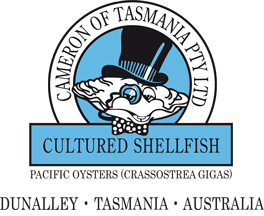
CAMERON OF TASMANIA
CULTURED SHELLFISH
Frequent asked questions
All oysters will have some smell if you open their packaging, this quickly dissipates, it is associated with being sealed in the plastic containers or associated packaging, and should not be of concern.
Q. Why do oysters have a brown (dark) spot on the body?
A. The brown spot is the visible gut. The gut cannot be seen when it is covered with sufficient glycogen (condition). The lack of visibility can be used as an indication of good condition.
Q. What is the greenish tinge on the oyster meat?
A. This is a result of the food the oyster eats, there is nothing wrong with the product. Oysters feed on micro algae and the colour of that algae can show in the oyster. Algae food species are generally green, brown, or golden brown. There are many other colours but these are the primary ones.
Q. What is the dark patch inside the shell?
A. It is most likely to be a parasite called a "mudworm". Mudworm appear in the shell as a gray track or as a blister in the shell. If blisters are broken they smell sulphurous. Mud worm and blisters are undesirable, mudworm tracks usually pose little or no problem, but blisters can break on opening or when cooking, tainting and ruining the product. Badly blistered oysters should be discarded.
Q. How long does it take for oysters to grow?
A. This depends on the location, water temperature and the size to which a farmer wishes to grow product to. As a rule of thumb it takes two and a half years to grow from a 3mm juvenile to a 7cm plate oyster. The method of grow-out affects the time, for example some growers use Intertidal systems, where the oysters are exposed at each low tide whereas some growers like Cameron's use Subtidal grow-out, which is faster becasue the oysters remain submerged, other than when removed for grading and cleaning procedures.
Q. Where do farmers get their oysters from in the first place?
A. Cameron of Tasmania, and other hatcheries produce juvenile oysters called seed or spat. These are supplied to farmers from 3mm upwards in length for on-growing and finishing.
Q. How can you tell if an oyster is "off"?
A. Trust your nose. Usually an oyster that is not suitable for consumption will have a smell, oysters should look and smell fresh, they usually have a hint of the sea which is a pleasant nose. Oysters that have a "fishy" smell should be discarded, oysters that look gray or slimy should be discarded.
Q. What should I do if I am unsure about the oysters I have purchased?
A. Contact your supplier or if you are still unsure call Cameron's, we will advise. Whether it's our product or not.
Q. How long will oysters last?
A. If left unopened, in a refrigerator at 2-4 degrees C approximately 7 days from the harvest date. Once opened they must be kept at a stable temperature as for live oysters. Fluctuations in temperature seriously reduce shelf life. Your oysters are best consumed as soon as possible after purchase but will last 4 days provided you treat them in the appropriate manner. You should always carry your trusty "Eski" with you when purchasing any seafood.
Q. Why do oysters from other places taste different?
A. Oysters will acquire the flavours of the sea. Oysters in clean crisp environments, such as those of Cameron's growing areas will carry those flavours to you. There is a great deal of variation in salinity in growing areas in Australia, the more salty the sea in the area the saltier the taste. In addition the food the oyster eats adds flavor. You may find that oysters grown in Tasmania are generally less salty than those grown in South Australia.
Q. How can I be sure oysters are safe to eat?
A. Cameron of Tasmania have their water sampled on a very regular basis to ensure that it is clean, "microbiologically speaking". In addition Tasmania has a monitoring program that tests farms and will not allow sales from farms unless they comply with set standards. The Program is called "The Tasmanian Shellfish Quality Assurance Program" it is administered by our health department.
Should you have specific questions, please contact Cameron of Tasmania or email us we will do our best to answer you questions accurately and as soon as possible.




